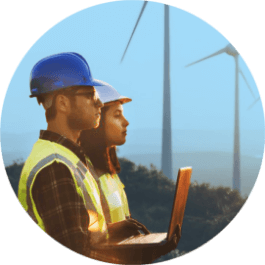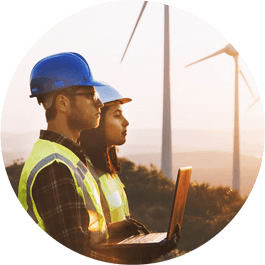Net metering is a crucial aspect of the effective integration of renewable energy, especially in the context of solar power. It allows users to reap more benefits from alternative energy sources, including fair billing, reduced utility expenses, and compensation for self-generated electricity.
We at Maxbill, as the company that provides energy billing solutions, will delve into how net metering functions, its advantages and disadvantages. We deliver the specifics of the UK market, and, most importantly what makes the ultimate billing solution for net metering.
Start exploring or pick the chapter you need the most. We factor in different levels of awareness and are ready to help you with billing for such services.
Let’s get started!
What is Net Metering?

Net metering typically involves billing consumers based on the total household consumption of utilities. However, excess electricity is returned to the grid for credits in renewable energy contexts like solar power. This enables homeowners or businesses to cut electricity costs through self-generation.
For instance, when a solar energy system produces more electricity than needed, the surplus is fed back into the grid. Consumers receive credits for this surplus, which they can use during low solar generation or high demand periods. Thus, consumers can harness solar energy’s benefits without extra expenses, even without dedicated battery storage systems.
Solar net metering is especially crucial, as it makes renewable energy economically viable. By utilising the grid as a storage medium, consumers save money, while utilities receive additional, cheaper energy to distribute among other users. Thus, the system benefits all participants.
Net metering policies vary by region and utility company. Some offer favourable terms, such as crediting surplus electricity at retail rates. However, others may impose limits on credited energy or offer lower buyback rates. These conditions are outlined in consumer contracts, allowing them to make informed decisions.
Related:
What is Utility Submetering? How Does It Work?
How Net Metering Works

Net metering is a system that operates on the following principle: solar (or wind) electricity generated by panels (or wind turbines) is supplied to the consumer’s grid, where it is utilized as needed. Any excess energy not consumed by the user is then fed back into the communal electric grid. In return, the consumer (owner of solar panels) receives credits proportional to the surplus energy sent to the grid.
Here’s how it works in practice:
- Consumers install solar panels or other renewable energy sources on their premises, along with an inverter that converts the generated direct current (DC) into alternating current (AC) for household or business use. This enables the solar panel to become part of the consumer’s electrical system.
- Excess solar energy is converted and sent to the grid during long sunny days, while the consumer utilizes electricity as required. Any surplus automatically goes into the communal electric grid. A bidirectional meter installed at the consumer’s end tracks the flow of electricity to and from the home.
- During shorter daylight hours or at night, consumers draw electricity from the grid when solar panels cannot generate enough energy. However, they do not pay the standard tariff; instead, they utilize credits earned from the surplus energy previously sent back.
At the end of the billing cycle, consumers settle any deficit in energy generated by their solar panels or receive compensation if they produce more than they consume. This system of solar net metering benefits solar panel owners by helping them save or even earn money. Additionally, it is advantageous for utility companies as they acquire additional resources at favourable prices.
In addition to that, it’s important to mention how important it is for utilities to leverage comprehensive electric billing software when combining convenient and renewable sources of electricity.
What is the Purpose of Net Metering?

Net metering serves two main purposes:
- Encouraging Consumers to Utilise Renewable Energy Sources More Often: This system has helped expand the production of self-generated electricity by businesses and individual homeowners, promoting their energy independence and offering them financial benefits in the form of compensation for the value of excess energy.
- Supporting the Effective Integration of Renewable Energy into the Grid: It allows utility companies to obtain free or cheap electricity, especially in months when grid demand increases (such as hot sunny days when consumers use air conditioners more frequently).
Additionally, it leads to a reduction in dependence on fossil fuels, thereby positively impacting the environment and the planet’s climate.
Pros and Cons of Net Metering
Net metering is applied to solar energy and any alternative energy sources, such as wind turbines. This solution has a range of advantages and several drawbacks. Let’s consider them all to form an objective view of this situation.
Pros and Benefits
- Consumers’ electricity bills decrease as they utilise their sources or even receive compensation in the form of credits from utility companies.
- Opting for solar stations, wind turbines, and other alternative energy sources enhances energy independence and system resilience to loads.
- Consumers gain more control over energy sources, benefiting and becoming less dependent on utility service providers.
- The stability and reliability of the power grid increase as there is a diversification of energy sources.
- Carbon emissions decrease and costs for expanding and maintaining the standard power grid are reduced.
- There is also the option of virtual net metering, which makes solar energy accessible to businesses and homeowners who do not own solar panels or other renewable energy sources.
Cons and Drawbacks
- The traditional power grid continues to exist despite the availability of alternative energy sources. This grid requires maintenance, repairs, updates, etc., and these costs are borne by actual consumers, which may lead to increased service costs for this group of subscribers.
- Compensation for electricity occurs at retail rather than wholesale rates, so consumers receive compensation higher than the price of excess energy received by the utility grid. This effectively subsidizes such users, which may be disadvantageous for the utility company.
- Renewable energy is not supplied continuously but in a wave-like pattern, creating difficulties in integrating such systems into the overall grid. Consequently, grid operators face challenges due to these fluctuations, attempting to find a balance between supply and demand.
- Since alternative energy is still relatively uncommon, each region has local regulations governing its management, which affects the economics of investment in such energy.
- Demand for electricity during peak hours (in the evening) does not decrease because, when the sun sets, all subscribers connect to the communal power distribution grid, creating increased demand on the system at this time.
- The more owners of alternative energy sources there are, the more challenging it becomes to manage effective resource distribution, as this may eventually lead to exceeding the nominal capacity of energy distribution infrastructure among subscribers.
Other Types of Net Metering

When considering the drawbacks of traditional solar net metering, one might notice the issue of subsidizing subscribers, where excess energy is compensated by the utility company at inflated rates. To address this drawback, alternative net metering options such as Buy All/Sell All, Net Billing, and Virtual Net Energy Metering (VNEM) can be utilized. These metering options are employed in some regions and states, providing a more transparent and equitable system of compensation for owners of alternative energy sources.
Buy All/Sell All
In this scenario, all electricity generated by the solar panels or wind turbines is sent to the grid, and the utility company purchases it at wholesale prices. Meanwhile, consumers use the grid as usual and pay for the services received according to the retail tariff. This results in lower compensation for excess generation but allows utility companies to raise additional funds for network maintenance, which is also a problem that needs addressing. To utilise this metering method, consumers require two meters: one for generated and sold electricity and another for actual consumption.
What is Net Billing?
Net Billing allows owners of alternative energy sources to receive compensation for net excess generation at a specified rate, which may differ from the retail rate. However, this system still ensures fair tariffing for all types of users.
Net Billing vs. Net Metering
Net Billing is different from Net Metering. You sell your excess energy to the utility for less than it would cost you to buy it as a customer. Your energy is treated like the energy of any large energy generator selling energy to the grid. Instead of a credit on your utility bill, you will receive a cash payment based on the supply rate or wholesale rate for your energy.
Usually, the retail rate at which you buy energy is higher than the wholesale rate at which you sell energy to the grid. Sometimes the price difference is 50-60%. This means you must pay extra to “buy back” the power.
Virtual Net Energy Metering (VNEM)
VNEM is a system that enables individuals to enjoy the benefits of net metering even without owning solar panels or wind turbines. Essentially, it allows for investment in solar “farms” and receiving credits as compensation for these investments, obtaining discounted electricity, which can reach up to 20%. This scheme is available only if a solar station exists at the chosen location, provided it is a community solar station that accepts such investments.
Can You Save on Your Electricity Bills with Net Metering?

Net metering was created so that subscribers could pay less for electricity while achieving energy independence. However, detailed calculations also include the cost of maintaining the station, additional equipment, network, etc. Therefore, the question should not be whether the use of solar energy will reduce electricity bills but rather how long it will take for this system to pay off for its owner.
Net Metering Credit Rollover
The more energy is generated, the higher the potential earnings (or savings on bills). If the system (panels or wind turbines) generates more energy than the subscriber consumes in a month, credits are carried over to the next billing cycle, allowing them to be used when energy consumption is higher or solar energy production is lower.
Value of Clean Metering Credits
Utility companies and local authorities regulate tariff settings for businesses and residents, including policies regarding the use of alternative energy sources. Therefore, the amount of compensation and the percentage of savings depends on the region. Overall, it can be assumed that the subscriber receives the full value for each kilowatt-hour (kWh) of excess energy produced.
Time of Use Rates
Time of Use (TOU) rates offered by utility companies allow for earning more from alternative energy during peak hours when system loads increase. Selling excess energy during these hours increases the profitability of alternative energy systems.
What Makes the Ultimate Billing Solution for Net Metering?

At MaxBill, we understand that creating the ultimate billing solution for net metering requires addressing several key pillars to ensure efficiency, fairness, and adaptability. Here are 5-10 essential elements that an ideal billing system should cover:
- Accurate Energy Measurement:
- The system must incorporate advanced metering infrastructure (AMI) that provides precise, real-time tracking of both energy consumption and production. This includes bidirectional meters that accurately record energy inflows and outflows.
- Transparent Credit Allocation:
- Ensure a clear and transparent process for crediting surplus energy to consumers. This includes detailed, easy-to-understand billing statements that show how credits are applied and carried over to future billing cycles.
- Flexible Tariff Structures:
- Offer a variety of tariff options to accommodate different consumer needs and regional policies. This might include time-of-use (TOU) rates, which provide higher compensation for energy exported during peak demand times, and seasonal rate adjustments.
- Integration with Renewable Energy Technologies:
- Seamlessly integrate with various renewable energy sources beyond solar, such as wind, hydro, and micro-CHP systems. This ensures that the billing system is adaptable and inclusive of multiple energy generation methods.
- Regulatory Compliance and Adaptability:
- Stay up-to-date with local and national regulations regarding net metering. The billing solution must be adaptable to policy changes to ensure compliance and continued consumer benefits.
- User-Friendly Interface:
- Provide an intuitive, user-friendly platform for consumers to monitor their energy usage, generation, and credits. This can include mobile apps or web portals that offer detailed insights and alerts.
- Support for Virtual Net Metering (VNEM):
- Incorporate provisions for virtual net metering, allowing users without direct access to renewable energy installations to participate and benefit from net metering through community solar programs or solar farms.
- Automated Billing and Reconciliation:
- Implement automated processes for billing and reconciliation to minimize errors and administrative overhead. This ensures timely and accurate billing cycles, reducing disputes and enhancing consumer trust.
- Educational Resources:
- Offer comprehensive educational resources to help consumers understand their bills, the net metering process, and how they can maximize their benefits. This empowers consumers to make informed decisions about their energy usage and investments.
- Enhanced Customer Support:
- Provide robust customer support to address queries and issues related to net metering and billing. This can include dedicated support lines, online chat options, and detailed FAQs.
Solar net metering in the UK

Two Significant Policies of the UK Government Concerning Net Metering
Homeowners who generate their own solar power in the UK can benefit from government policies that enable them to “sell” surplus energy to the grid in return for payments. The UK government has implemented two key policies to support this initiative.
Overview of the Feed-in Tariff (FiT)
The first significant policy, the Feed-in Tariff (FiT), was in effect until 2019. This policy was designed to encourage the adoption of renewable energy technologies by offering financial incentives. Under the FiT scheme, utility companies paid a fixed rate for the electricity homeowners exported to the grid, guaranteeing these payments for up to 20 years. This scheme was instrumental in promoting the switch to renewable energy sources.
Introduction of the Smart Export Guarantee (SEG)
Following the closure of the FiT to new applicants, the UK government introduced the Smart Export Guarantee (SEG) as a replacement. The SEG is a form of net metering that allows solar panel owners to earn a rate per unit of electricity they export to the grid. This scheme can significantly benefit solar energy producers, with potential annual earnings ranging from £80 to £165. When combined with the savings from using solar power, these earnings can expedite the return on investment for solar installations.
Eligibility and Requirements for the Smart Export Guarantee
The Smart Export Guarantee is accessible not only to solar panel owners but also to those using other renewable energy technologies such as wind, hydro, micro-CHP, and anaerobic digestion. To qualify for the SEG, the technology must be installed in Great Britain and have a total installed capacity of no more than 5 Megawatts (MW), or 50 kilowatts (KW) for micro-CHP systems.
To access the SEG, one must first research and select a utility company that offers SEG payments, as each licensee may provide different tariffs. Certification of the solar PV installation, typically with an MCS certificate or equivalent, is required. Additionally, it is necessary to have a meter capable of half-hourly readings and ensure it has a unique MPAN for exported electricity. Consulting with the chosen licensee about the suitability of the existing meter setup or the need for a smart meter installation is also essential.
The application process involves applying directly through the selected SEG licensee, who will then provide the application details and confirm acceptance, tariff, and contract length.
Is Net Metering the Future?

Solar net metering has served as a significant incentive for many businesses and homeowners to actively install solar panels and wind turbines to reduce energy costs and make it more accessible.
On the one hand, this has reduced the burden on the communal resource distribution system and allowed many consumers to be independent of general tariffs. Furthermore, it has positively impacted climate, ecology, and the efficient use of fossil fuels. It seems to have only positive aspects and meets the demands of modern society. However, the implementation of such systems and their integration with existing communal networks still pose challenges. Nevertheless, these challenges are worth overcoming, as the future of net metering will allow individual consumers and entire countries to enjoy all the benefits of such solutions.
































